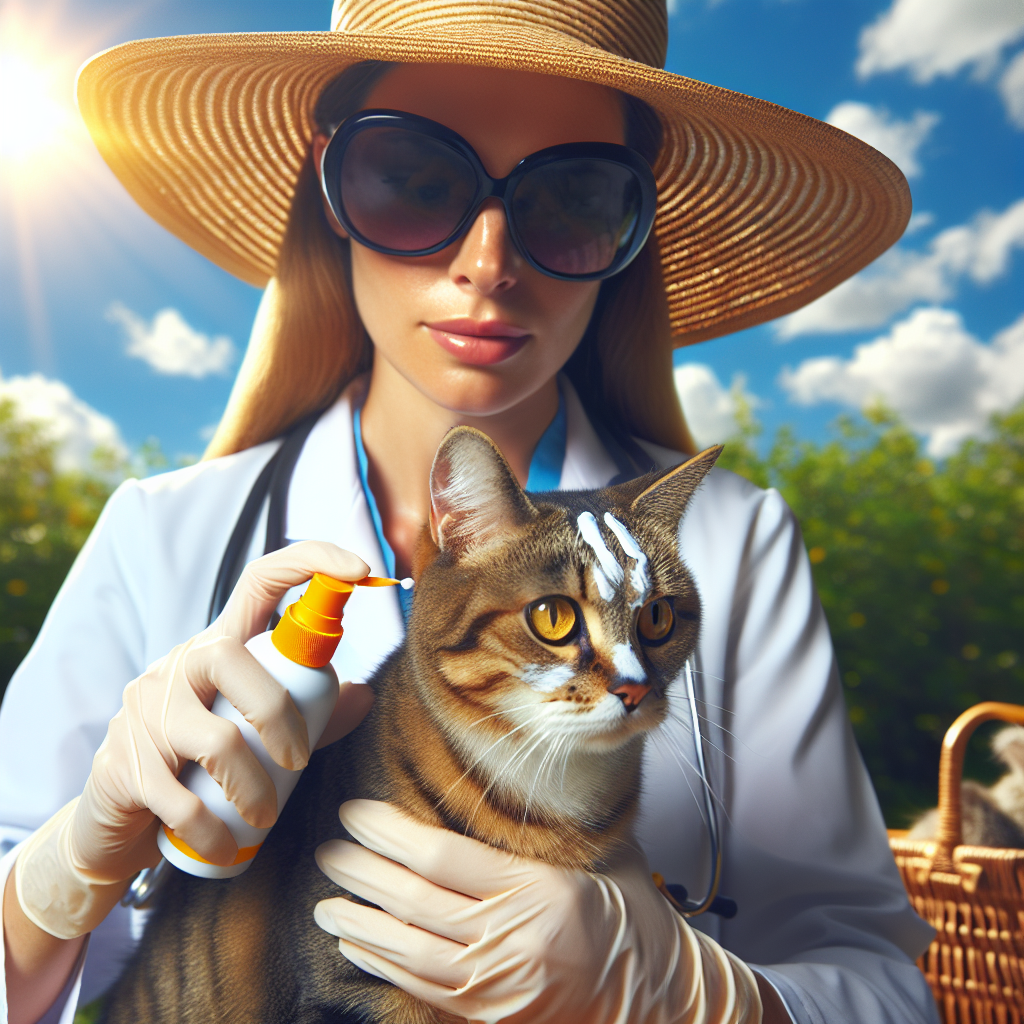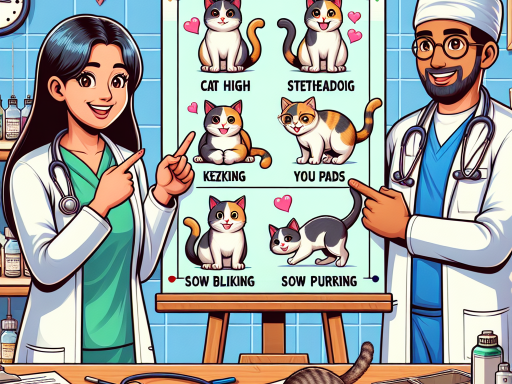Introduction to Cat Sunscreen
Hey there, fellow cat enthusiasts! Have you ever thought about whether your furry friend needs sunscreen? It might sound a bit unusual at first, but just like humans, cats can also suffer from the sun’s harsh rays. Intrigued? Let’s dive into the surprising world of cat sunscreen and uncover why it’s becoming a must-have in every cat parent’s care routine.
Why Sunscreen for Cats?
We all know that cats love to bask in the sunshine, right? There’s something irresistibly charming about seeing our feline friends stretched out on a sunlit windowsill or frolicking in the backyard. But here’s the catch: the sun isn’t always a cat’s best friend. Just like us, cats can get sunburned, and over time, this exposure can lead to more serious conditions like skin cancer.
Who Needs It Most?
Not all cats are equally at risk. Some cats are more susceptible to the sun’s harmful effects, especially those with light-colored or thin fur. If your kitty has a white coat or pink skin, they might need extra protection. Additionally, areas with little to no fur, like the tips of the ears, nose, belly, and around the eyes, are particularly vulnerable to sunburn.
Common Misconceptions
One common misconception is that indoor cats are safe from sun damage. However, UV rays can penetrate windows, putting even the most housebound feline at risk. So, whether your cat is an indoor sunbather or an outdoor explorer, sunscreen could play a crucial role in keeping them safe.
Understanding Cat Sunscreen
Now, you might be wondering, “Isn’t sunscreen just for humans?” Not quite! Human sunscreen often contains ingredients that are toxic to cats. This is why it’s so important to use a product specifically formulated for feline friends. Cat-friendly sunscreens are designed to be safe if your kitty licks or grooms themselves after application.
Benefits of Using Cat Sunscreen
So, what are the benefits of investing in a good cat sunscreen? Let’s break it down:
- Prevents sunburn: Just like in humans, sunburn in cats can be painful and lead to more serious skin issues over time.
- Reduces skin cancer risk: Prolonged sun exposure increases the risk of skin cancer. Sunscreen acts as a protective barrier, reducing this risk.
- Protects sensitive areas: Sunscreen helps shield those delicate and less furry spots from UV damage.
Is Sunscreen Enough?
While sunscreen is a fantastic tool, it’s not the only way to protect your cat from the sun. Combining sunscreen with other protective measures, like shaded areas or sun-protective clothing, can offer comprehensive protection. But we’ll get into those details in another section!
Wrapping It Up
In a nutshell, cat sunscreen might seem like an unconventional idea, but it’s a game-changer when it comes to protecting your feline friend from the sun’s damaging effects. Your kitty’s health and happiness are worth it, don’t you think? Stay tuned as we explore more about why cats need sunscreen and how to choose the right one in the upcoming sections. Until then, give your cat some extra pets and maybe a cozy spot in the shade!
Why Cats Need Sunscreen
Hey there, fellow cat lover! You might be wondering why on earth your feline friend would need sunscreen. After all, they’re covered in fur, right? Well, believe it or not, cats can be just as susceptible to the dangers of the sun as we are. Let’s dive into the reasons why your kitty needs some extra sun protection.
1. Fur Isn’t Foolproof
Yes, cats have fur, but that doesn’t mean they are completely shielded from the sun’s powerful rays. Cats with light-colored or thin fur are particularly vulnerable. Just as fair-skinned humans are more prone to sunburn, so are white or light-colored cats. Even darker-furred cats can have areas of their body where the fur is thinner, like the ears, nose, and belly, which can easily get sunburned.
2. Cats Love Sunbathing
Have you ever noticed how your cat loves to stretch out in that sunny spot on the floor? Cats are natural sun-seekers and they bask in the warmth, sometimes for hours. While soaking up the sun is one of their favorite pastimes, prolonged exposure can increase the risk of sunburn and other sun-related issues.
3. Sun Exposure Can Lead to Skin Cancer
This is where things get serious. Just like humans, cats can develop skin cancer from too much sun exposure. Squamous cell carcinoma is the most common type of skin cancer in cats, and it often affects areas exposed to the sun, like the tips of the ears, eyelids, and nose. Using sunscreen can help minimize this risk.
4. Protecting Vulnerable Cats
Some cats are more vulnerable to sun damage than others. Cats with certain conditions, such as autoimmune diseases, can have heightened sensitivity to the sun. Also, hairless breeds like the Sphynx are at an even greater risk since they don’t have any fur to provide natural protection. For these cats, sunscreen is a must.
5. Indoor Cats Aren’t Safe Either
Think indoor cats are safe from sun damage? Think again! Even if your cat spends most of its time indoors, it can still get sunburned through windows. Glass windows filter out some UV rays but not all, so your indoor kitty lounging by the window could still use some protection.
6. Age Matters
Kittens and senior cats have more sensitive skin compared to adult cats. Kittens have thinner skin that can burn more easily, and older cats might have compromised skin due to age or health conditions. Ensuring they’re protected from the sun is especially important.
7. Peace of Mind for Pet Parents
Let’s be honest, we all want the best for our furry friends. By understanding the importance of protecting your cat from the sun, you’re taking a proactive step in ensuring their health and well-being. Applying sunscreen specifically designed for cats can give you peace of mind that you’re safeguarding them against potential harm.
So there you have it! While it might seem a bit unusual at first, sunscreen for cats makes a lot of sense when you consider all these factors. It’s a simple step you can take to keep your beloved kitty safe and happy.
Risks of Sun Exposure for Cats
While we often think of cats as independent and self-sufficient creatures, they actually need our help when it comes to protecting them from the sun’s harmful rays. Just like humans, cats can suffer from sunburn, skin cancer, and other serious health issues if they are exposed to too much sunlight without protection.
One of the main risks of sun exposure for cats is the potential for sunburn. Cats with light-colored fur or thin coats are particularly susceptible to sunburn, especially on their ears, nose, and other areas with less hair coverage. Sunburn can be painful for cats and can even cause their skin to peel and blister, leading to discomfort and potential infection.
Furthermore, prolonged sun exposure can also increase the risk of skin cancer in cats. Just like in humans, UV rays can damage the DNA in a cat’s skin cells, leading to the development of cancerous growths. Cats with white or light-colored fur, as well as those with thin coats, are at a higher risk for developing skin cancer due to sun exposure.
In addition to sunburn and skin cancer, cats can also suffer from heatstroke if they are exposed to excessive sunlight and heat. Cats are not as efficient at regulating their body temperature as humans, and they can quickly become overheated if they are left in direct sunlight for too long. Heatstroke is a serious medical emergency that can be life-threatening if not treated promptly.
It’s important to remember that cats groom themselves by licking their fur, which means that sunscreen designed for humans should never be used on cats. Human sunscreen contains ingredients that can be toxic to cats if ingested, so always make sure to use a sunscreen specifically formulated for feline use.
By understanding the risks of sun exposure for cats and taking proactive measures to protect them, you can help keep your furry friend safe and healthy all year round. From applying sunscreen to providing ample shade and hydration, there are many ways you can ensure that your cat stays protected from the sun’s harmful rays.
“`html
Risks of Sun Exposure for Cats
While we often think of cats as independent and self-sufficient creatures, they actually need our help when it comes to protecting them from the sun’s harmful rays. Just like humans, cats can suffer from sunburn, skin cancer, and other serious health issues if they are exposed to too much sunlight without protection.
One of the main risks of sun exposure for cats is the potential for sunburn. Cats with light-colored fur or thin coats are particularly susceptible to sunburn, especially on their ears, nose, and other areas with less hair coverage. Sunburn can be painful for cats and can even cause their skin to peel and blister, leading to discomfort and potential infection.
Furthermore, prolonged sun exposure can also increase the risk of skin cancer in cats. Just like in humans, UV rays can damage the DNA in a cat’s skin cells, leading to the development of cancerous growths. Cats with white or light-colored fur, as well as those with thin coats, are at a higher risk for developing skin cancer due to sun exposure.
In addition to sunburn and skin cancer, cats can also suffer from heatstroke if they are exposed to excessive sunlight and heat. Cats are not as efficient at regulating their body temperature as humans, and they can quickly become overheated if they are left in direct sunlight for too long. Heatstroke is a serious medical emergency that can be life-threatening if not treated promptly.
It’s important to remember that cats groom themselves by licking their fur, which means that sunscreen designed for humans should never be used on cats. Human sunscreen contains ingredients that can be toxic to cats if ingested, so always make sure to use a sunscreen specifically formulated for feline use.
By understanding the risks of sun exposure for cats and taking proactive measures to protect them, you can help keep your furry friend safe and healthy all year round. From applying sunscreen to providing ample shade and hydration, there are many ways you can ensure that your cat stays protected from the sun’s harmful rays.
“`
Choosing the Right Sunscreen for Your Cat
So, you’re thinking about protecting your feline friend from the sun’s harmful rays? That’s fantastic! Cats, especially those with lighter fur or exposed skin, can be at risk for sunburn just like us humans. But don’t worry! With the right sunscreen, you can keep your kitty safe and sunburn-free.
Why Not Just Use Human Sunscreen?
First things first: never use human sunscreen on your cat. Human sunscreens often contain ingredients like zinc oxide and salicylates, which can be toxic to cats. These substances can cause stomach upset or even more severe health issues if your cat licks them off. So, it’s crucial to choose a product specifically designed for pets.
Look for Pet-Safe Ingredients
When selecting a sunscreen for your cat, you want to make sure it contains pet-safe ingredients. Look for products that are free from harmful chemicals. Ingredients like titanium dioxide are generally considered safe for pets, as they sit on top of the skin rather than being absorbed.
Opt for Fragrance-Free
Cats have incredibly sensitive noses. Choosing a fragrance-free sunscreen will not only make the application process easier but also ensure your cat is more comfortable. Strong scents can be off-putting to cats, making them less likely to tolerate the sunscreen.
Water-Resistant Formulas
While cats aren’t known for their love of water, choosing a water-resistant formula ensures that the sunscreen will stay on longer, even if they decide to groom themselves. This type of sunscreen provides longer-lasting protection and reduces the frequency of reapplication.
Check for Veterinary Approval
One of the safest ways to select a sunscreen for your cat is by purchasing one that your veterinarian recommends. Many pet sunscreen products will have a label indicating veterinary approval, giving you peace of mind that the product is safe and effective.
Read Reviews
Before finalizing your purchase, take a moment to read reviews from other pet owners. Their experiences can provide valuable insights into how well a product works and how easy it is to apply. Look for reviews mentioning cats with similar skin and fur types to your own pet for a more accurate idea of how the product will perform.
Patch Test First
Once you have the sunscreen, it’s always a good idea to do a small patch test. Apply a tiny amount to a small area of your cat’s skin and wait 24 hours to see if there’s any reaction. If your cat shows signs of irritation, redness, or itchiness, discontinue use immediately and consult your vet.
Ease of Application
Consider how easy the product is to apply. Sunscreen comes in various forms like spray, lotion, and wipes. Choose one that you think will be least stressful for both you and your cat. Sprays might be easier for quick application, while lotions can be more controlled.
Consider Special Needs
If your cat has specific health issues, such as allergies or skin conditions, it’s especially important to consult your vet before choosing a sunscreen. There are specially formulated products for cats with sensitive skin that can offer protection without causing irritation.
Conclusion
Choosing the right sunscreen for your cat might seem like a daunting task, but with a bit of research and care, you’ll find a product that keeps your furry friend safe and happy. Always consult your vet, read ingredient labels carefully, and opt for products designed specifically for pets. Your cat will thank you for it, even if they don’t show it!
By taking these steps, you can ensure that your cat has a sun-safe summer ahead. Happy sunbathing!
How to Apply Sunscreen to Your Cat
Now that you know why cats need sunscreen and the risks of sun exposure for our feline friends, let’s talk about how to properly apply sunscreen to your cat. Here are some tips to make sure your cat stays safe in the sun:
1. Choose the Right Sunscreen
Make sure you are using a sunscreen specifically formulated for cats. Human sunscreen can be toxic to cats, so it’s important to use a pet-safe sunscreen. Look for sunscreens that are fragrance-free, non-toxic, and specifically designed for cats.
2. Start Slow
Introduce your cat to sunscreen gradually. Start by applying a small amount of sunscreen on a small area of your cat’s skin to see how they react. If they seem uncomfortable, try a different sunscreen or consult your veterinarian for advice.
3. Apply Sunscreen to Vulnerable Areas
Focus on applying sunscreen to your cat’s vulnerable areas such as the ears, nose, belly, and any areas with thin fur or exposed skin. These areas are more prone to sunburn and skin damage, so make sure you cover them well with sunscreen.
4. Use a Gentle Touch
Gently massage the sunscreen into your cat’s skin, making sure to cover all the exposed areas. Be gentle and patient, as some cats may not enjoy the sensation of sunscreen being applied. Use slow and soothing movements to make the process more comfortable for your furry friend.
5. Reapply as Needed
Remember to reapply sunscreen every few hours, especially if your cat is spending extended periods of time in the sun. Even waterproof sunscreens can wear off over time, so make sure to keep an eye on your cat and reapply sunscreen as needed to ensure they stay protected.
6. Monitor for Signs of Discomfort
Keep an eye on your cat after applying sunscreen to make sure they are comfortable. If your cat is excessively grooming the sunscreen off, showing signs of irritation, or behaving differently, remove the sunscreen immediately and consult your veterinarian for further guidance.
By following these steps and taking the time to properly apply sunscreen to your cat, you can help protect them from the harmful effects of sun exposure. Remember, prevention is key when it comes to keeping your furry friend safe and healthy in the sun!
Signs of Sunburn in Cats
We all know that sunburns are no fun for us humans, but did you know that your feline friend can also suffer from them? Cats, especially those with light-colored fur or thin coats, can be vulnerable to the harsh effects of the sun. Spotting the signs of sunburn early can help you alleviate your kitty’s discomfort and protect them from more serious damage. Let’s dive into the warning signs you should look out for.
Common Symptoms of Sunburn
Identifying sunburn in cats isn’t always straightforward, but there are some telltale signs that might clue you in:
- Red or pink skin: This is especially noticeable in areas with less fur like the nose, ears, and belly.
- Hair loss: Sometimes, the fur might thin out or fall off in patches where the skin has been burned.
- Warm to the touch: If you notice that your cat’s skin feels warmer than usual, it might be a sign of sunburn.
- Dry, cracked skin: Just like humans, cats can develop dry, flaky skin after too much sun exposure.
- Blisters or sores: In severe cases, you might see blisters or open sores on your cat’s skin.
- Discomfort or pain: Your cat might seem more sensitive to touch in burnt areas and may groom excessively or avoid being petted.
Behavioral Changes
In addition to physical symptoms, sunburn can cause changes in your cat’s behavior. Pay attention if your cat:
- Becomes more irritable: If your usually affectionate kitty is suddenly grumpy, it could be because they’re in pain.
- Over-grooming: Cats often lick their wounds, so excessive grooming might indicate they’re trying to soothe sunburned skin.
- Avoids sunlight: If your sun-loving cat is suddenly shunning their favorite sunny spots, it might be a sign they’ve had too much sun.
- Shows reluctance to be touched: If your cat flinches or pulls away when you pet them, especially in areas like the ears or nose, it might be due to sunburn.
When to Consult Your Vet
Not all sunburns require a trip to the vet, but it’s important to know when to seek professional help. Here are some scenarios where a vet visit is warranted:
- Severe burns: If your cat has blisters, open sores, or extensive areas of burned skin, it’s time to see the vet.
- Signs of infection: If the skin looks swollen, has pus, or appears to be getting worse instead of better, consult a vet.
- Persistent symptoms: If the sunburn doesn’t seem to be healing after a few days, it’s best to get a professional opinion.
- General health concerns: If your cat seems lethargic, stops eating, or shows other signs of illness, a vet visit is a good idea.
Home Care Tips
If you suspect your cat has a mild sunburn, there are a few steps you can take to provide relief at home:
- Keep them indoors: Give your cat a break from the sun to prevent further damage.
- Cool compresses: Gently apply a cool (not cold) wet cloth to the affected areas to soothe the skin.
- Aloe vera gel: Use a pet-safe aloe vera gel to help moisturize and heal the skin.
- Monitor and soothe: Keep an eye on the sunburn and offer plenty of love and comfort to help your cat feel better.
Remember, prevention is always better than cure. By keeping an eye out for the signs of sunburn and taking steps to protect your cat from the sun, you’ll help ensure they stay happy and healthy.
Additional Sun Protection Tips for Cats
So, you’ve got your cat sunscreen and you’ve mastered the art of applying it to your feline friend. But there’s more you can do to protect your cat from the harmful effects of the sun. Here are some additional tips to keep your furry friend safe and happy:
1. Limit Sun Exposure
Just like humans, cats can get sunburned if they spend too much time in the sun. Try to keep your cat indoors during peak sun hours, typically between 10am and 4pm. If your cat does go outside, provide shady spots for them to relax in and consider using a cat-safe sunscreen on exposed areas.
2. Provide Plenty of Water
Hydration is key to keeping your cat cool and comfortable in the sun. Make sure they have access to fresh water at all times, especially on hot days. Dehydration can lead to heatstroke, so it’s important to keep your cat well-hydrated.
3. Create a Cat-Friendly Environment
If your cat enjoys spending time outdoors, create a cat-friendly environment that offers both sun and shade options. This could include a catio (enclosed outdoor space) or a cat tree with built-in sun shelters. By providing these options, you give your cat the choice to seek shade when needed.
4. Monitor Your Cat’s Behavior
Keep an eye on your cat’s behavior when they are outside in the sun. If you notice signs of discomfort, such as excessive panting, lethargy, or seeking shade frequently, it’s time to bring them indoors. Cats are masters at hiding signs of distress, so it’s up to us to pay close attention to their behavior.
5. Consult Your Veterinarian
If you have any concerns about your cat’s sun exposure or if you notice signs of sunburn, it’s best to consult your veterinarian. They can provide guidance on how to protect your cat from the sun and recommend any necessary treatments for sunburn.
By following these additional sun protection tips, you can help keep your cat safe and comfortable in the sun. Remember, a little extra care goes a long way in ensuring your furry friend stays healthy and happy!





